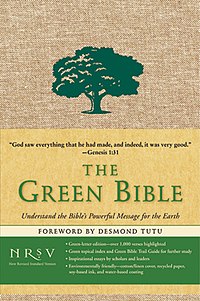The Green Bible is an English version of the New Revised Standard Version Bible with a focus on environmental issues and teachings.[1] It was originally published by Harper Bibles on October 7, 2008. It is a study Bible featuring a foreword by Desmond Tutu and essays by Matthew Sleeth, Calvin B. DeWitt, Pope John Paul II, Brian McLaren, Ellen Bernstein, Ellen F. Davis, James Jones (bishop), N.T. Wright, Barbara Brown Taylor, and Gordon Aeschliman.
 Cover | |
| Author | various |
|---|---|
| Subject | Religion, environmentalism |
| Publisher | Harper Bibles |
Publication date | 2008 |
| ISBN | 978-0-06-162799-6 |
| OCLC | 227199080 |
Background edit
The Green Bible is meant to "equip and encourage [readers] to see God's vision for creation and help [them] engage in the work of healing and sustaining it".[2] Emphasizing what the publishers see as the Bible’s message on the environment, all passages mentioning the environment are printed in green ink to draw the reader’s attention.[3]
Inspiration edit
Mark Tauber, senior vice-president of HarperOne, has stated that the Green Bible was developed with the intention of being "the first ever specialty bible that takes the issues of sustainability, stewardship of the earth, what many in the religious community call 'creation care' very seriously".[4] He went further, exposing on the Green Bible’s purpose: "That the Bible has a profound message of sustainability—some might argue, the original message—is not all that surprising. What is surprising is that it is not one of the first things that comes to mind when most folks think about the Bible and its message. This Bible seeks to change that fact. We believe that the unique and specially added features by some of today's most important thinkers, writers and leaders, across the ecumenical spectrum make it a must-have for those who already find motivation, comfort and inspiration in it and for the many more who might see it freshly as a critical resource in their journey to sustain our planet".[1]
HarperOne also claims the Bible contains more references to the environment than it does about love or most other subjects.[4]
Construction edit
The Green Bible is meant to be a study bible, and features a "green trail study guide" of the Bible, directing readers to specific verses on the environment and stewardship.[5] Additionally, it features a topical index for finding verses pertaining to specific subjects. Before the biblical text, the Green Bible provides an introduction from Archbishop Desmond Tutu and essays from Brian McLaren, Cal DeWitt, Barbara Brown Taylor, Pope John Paul II, Ellen F. Davis, N. T. Wright, Ellen Bernstein, Matthew Sleeth, James Jones, and Gordon Aeschliman. Verses involving the environment or the earth are highlighted in green to draw reader’s attention.
Notable theologians including Archbishop Desmond Tutu and conservative N.T. Wright contributed material to the edition’s supplemental reading. To further support the green cause, HarperCollins printed the Green Bible on recycled paper, used soy-based ink,[6] and made the cover from renewable cotton linen.[7]
Reception edit
The Sierra Club, The Humane Society, and the Eco-Justice Program have all officially endorsed the Green Bible.[4] Reaction to the Green Bible among Christian leaders has been mixed. Some leaders have praised the concept of the Green Bible, but have raised issues with how some content is presented, stating that the environmental message deemphasizes the Bible’s central message of the Gospels.[7] Richard Land, head of the Southern Baptist Convention’s Ethics & Religious Liberty Commission said about the edition: "Sure it's important, but when they asked Jesus what was most important, he said, 'Love your God, and love your neighbor as yourself.' He didn't say anything about creation".[8]
Evangelist Matthew Sleeth stated that the Green Bible may help bridge the gap between liberal and conservative Christians.[9]
Reception among political leaders edit
Reception to the Green Bible has also been differed among political leaders. Larry Schweiger, President of the National Wildlife Federation praised the Green Bible for giving "solid context" for environmentalism.[7] In contrast, some conservatives, like talk show host Pat Gray, accused the Green Bible of merely being a marketing gimmick and money-making scheme for HarperCollins.[10]
See also edit
References edit
- ^ a b "Bible Goes Green: A Publishing First". The Green Blog. Sundance Channel. 15 September 2008. Archived from the original on 18 September 2008. Retrieved 31 December 2008.
- ^ The Green Bible. New York City: HarperOne. 2008.
- ^ Marrapodi, Eric (24 December 2008). "Repackaging the Bible". CNN. Retrieved 31 December 2008.
- ^ a b c "Get Involved". The Green Bible. HarperOne. 2008. Retrieved 31 December 2008.
- ^ Walker, Andrea (14 July 2008). "The Green Gospel". The New Yorker. Retrieved 31 December 2008.
- ^ Scheinin, Richard (19 December 2008). "The Bible: So many to choose from". San Jose Mercury News. Retrieved 31 December 2008.
- ^ a b c Livingston, Layron (30 December 2008). "The Bible has gone green". KLTV. Retrieved 31 December 2008.
- ^ Biema, David Van (18 September 2008). "The Bible Goes Green for the Prius Age". Time Magazine. Archived from the original on September 22, 2008. Retrieved 31 December 2008.
- ^ Derakhshani, Tirdad (23 December 2008). "Updates aim to put the Bible in vogue". The Philadelphia Inquirer. Archived from the original on December 25, 2008. Retrieved 31 December 2008.
- ^ The Glenn Beck Program. 31 December 2008.